We recently enjoyed framing a batch of circa 1910 canvases by Charles Warren Eaton (1857–1937). Eaton was one of the leading members of the nineteenth century tonalist movement, and a protege of the most prominent tonalist artist—indeed, one of the most important American artists of his time—George Inness. A couple of posts back I wrote about framing an Inness painting. (An earlier post on framing an Eaton is here.) Like the Inness, these by Eaton, below, were also framed for, and are available from, our friends at California Historical Design.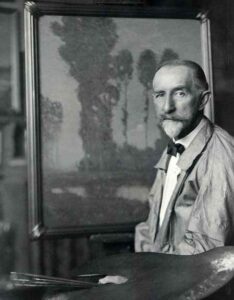
Tonalism sprung from deeply religious strivings for harmony, and observation of nature informed by a belief in “spiritual influx”—the holy spirit’s pervasive manifestation in nature. Key to its concerns were heightened sensitivity to the harmonies of light and shadow, which renders tonalism extraordinarily well-suited to dark wood frames. Such settings naturally respect a tonalist work’s low value contrast and the complementary effect of shadow tones on the picture’s lighter values. The gold convention on such paintings is especially unsuitable, so it’s always gratifying to rescue them from that treatment. The frame-maker’s obligation to harmonize the frame with the painting—in line, form and texture as well as color, tone and value—is never felt more strongly than in framing tonalist works.
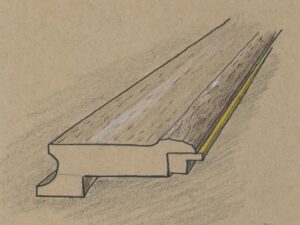 This first painting, which is untitled and undated, is 12″ x 16″. We set it in a quartersawn white oak frame with Saturated Medieval Oak stain. The profile, as you can see from the drawing here, is mostly flat but has a carved raised cushion at the sight edge. I’m very pleased with the complementary cove transition between the flat and the raised cushion. The slip has a bronze wax finish. (The painting is available here.)
This first painting, which is untitled and undated, is 12″ x 16″. We set it in a quartersawn white oak frame with Saturated Medieval Oak stain. The profile, as you can see from the drawing here, is mostly flat but has a carved raised cushion at the sight edge. I’m very pleased with the complementary cove transition between the flat and the raised cushion. The slip has a bronze wax finish. (The painting is available here.)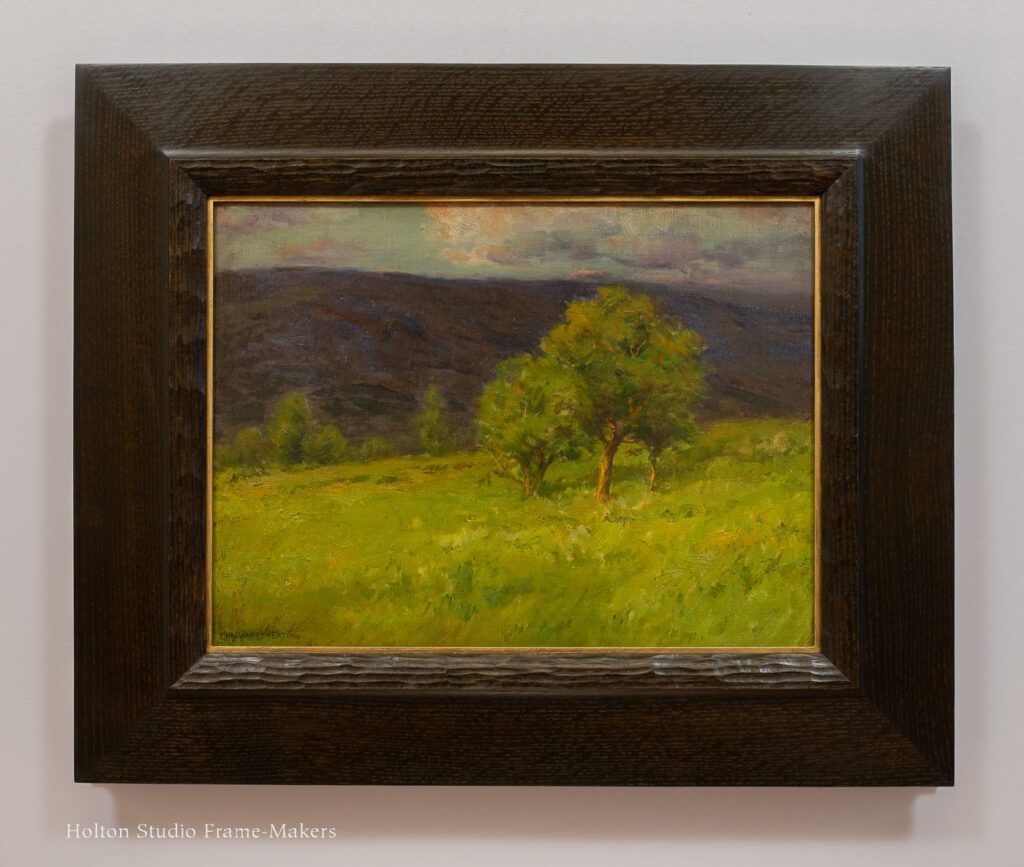 In this view below, you can see the coved back, which reaches out slightly beyond the outside edge of the frame’s face.
In this view below, you can see the coved back, which reaches out slightly beyond the outside edge of the frame’s face.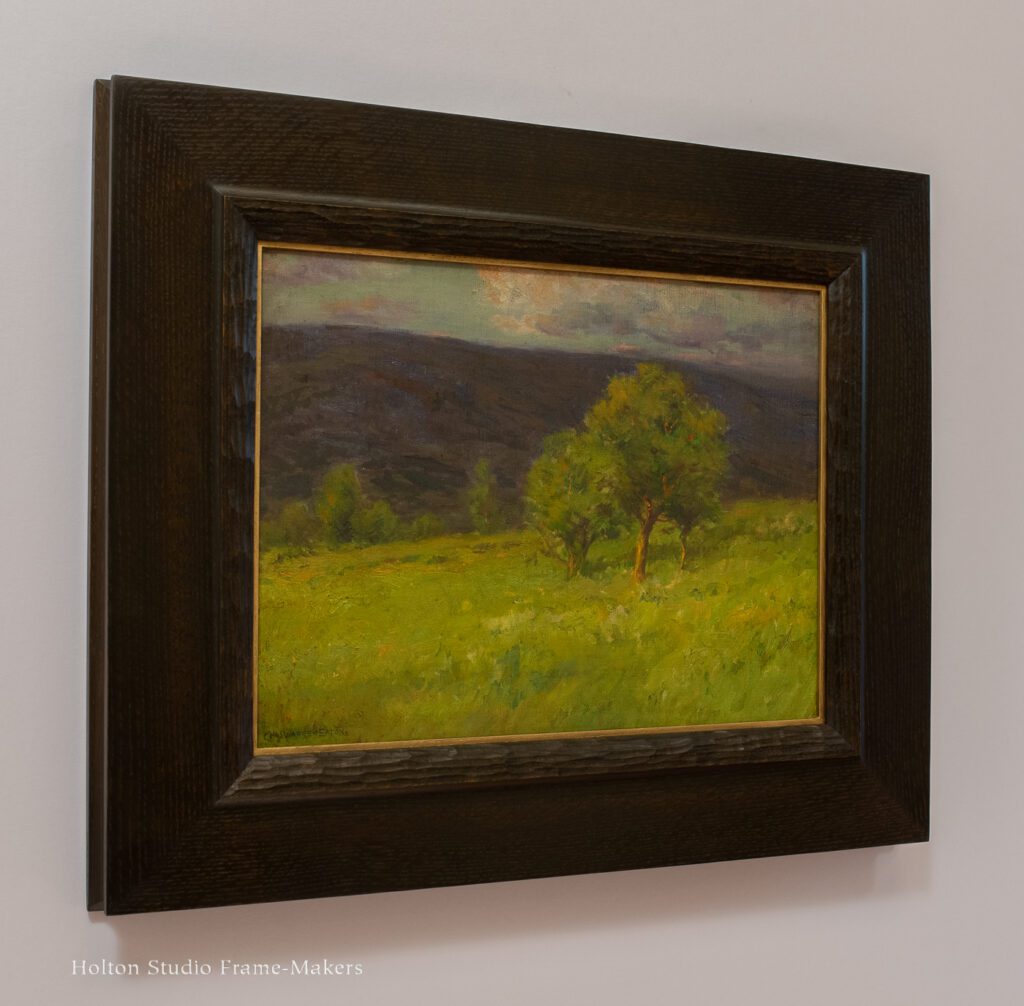 This painting below, also undated, is titled “The Clearing In Winter.” At 24″ x 20″, it’s the largest of the set. Our 4″ wide compound mitered frame, No. 2.3 CV + Cap 400 CV, is a slope which I chose to extend the picture’s perspective. It has a carved cove sight edge and carved cushion cap molding. The wood is quartersawn white oak stained Medieval Oak. The liner is an ovolo (quarter round), carved and gilded. Charles Warren Eaton’s “The Clearing in Winter” is available here.
This painting below, also undated, is titled “The Clearing In Winter.” At 24″ x 20″, it’s the largest of the set. Our 4″ wide compound mitered frame, No. 2.3 CV + Cap 400 CV, is a slope which I chose to extend the picture’s perspective. It has a carved cove sight edge and carved cushion cap molding. The wood is quartersawn white oak stained Medieval Oak. The liner is an ovolo (quarter round), carved and gilded. Charles Warren Eaton’s “The Clearing in Winter” is available here.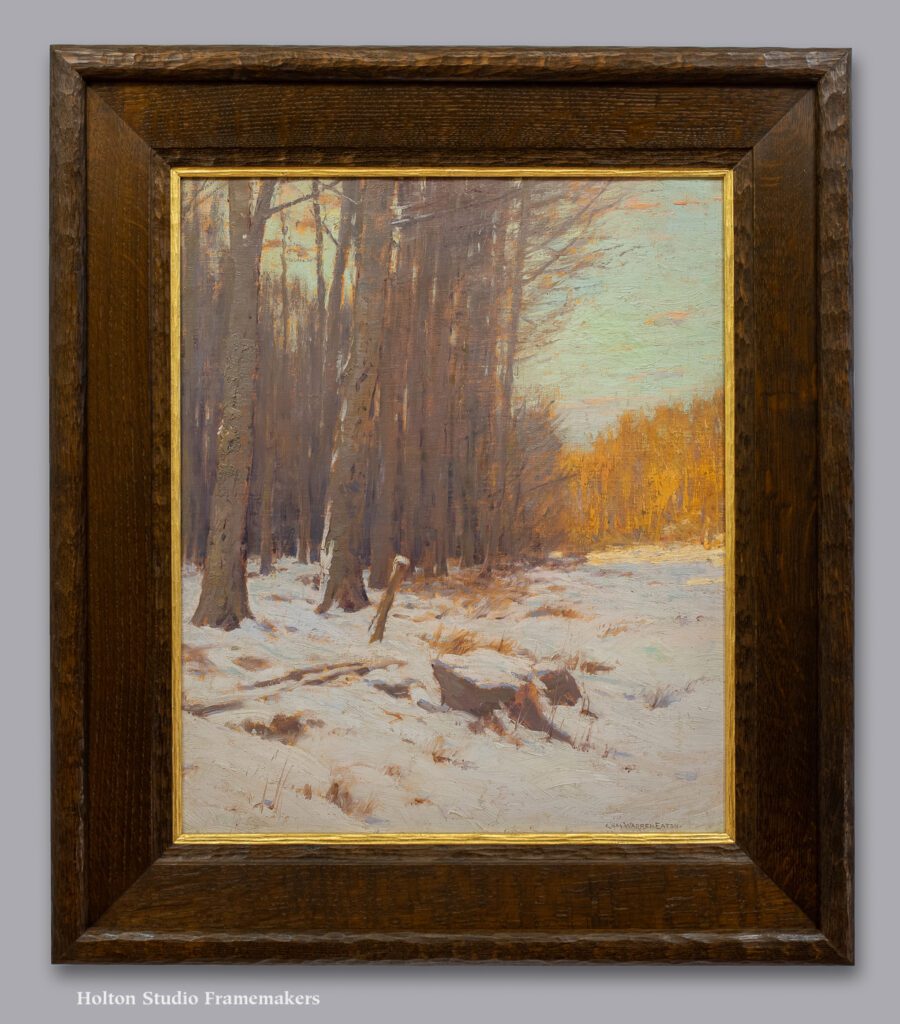
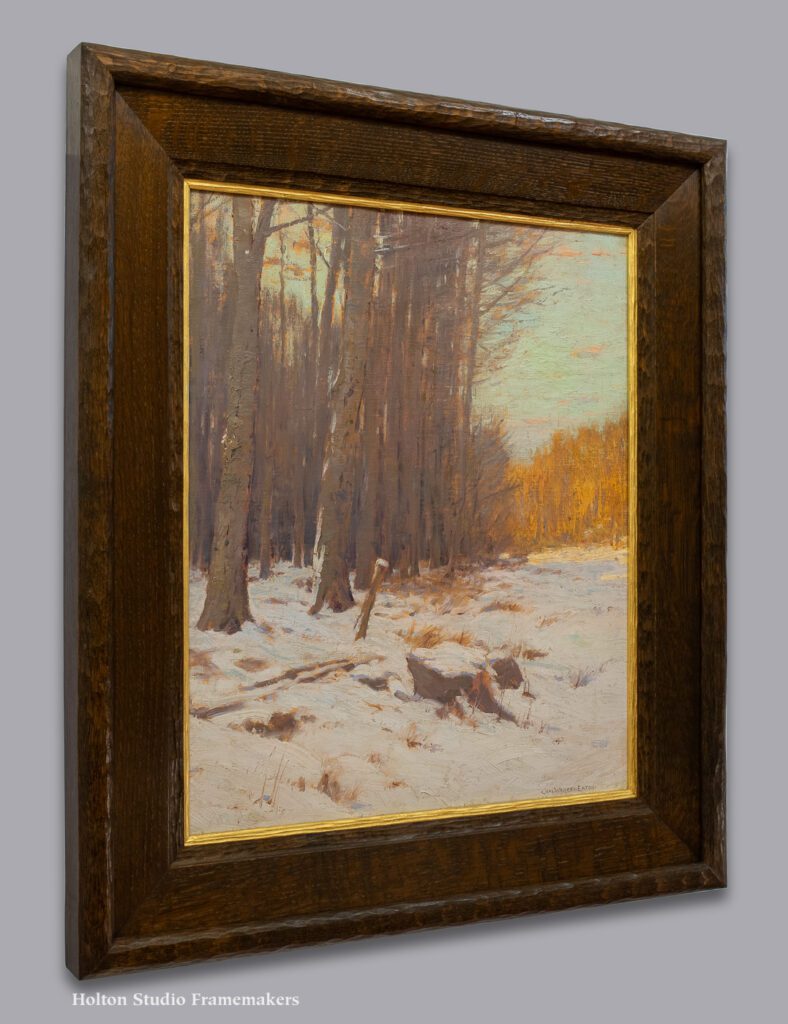 The 12″ x 18″ haystacks painting below got the same treatment as the Inness painting in my recent post—a carved compound cushion form with a cove inner molding. The frame is quartersawn white oak with Dark Medieval Oak stain and has a bronze wax slip. The back is cut in.
The 12″ x 18″ haystacks painting below got the same treatment as the Inness painting in my recent post—a carved compound cushion form with a cove inner molding. The frame is quartersawn white oak with Dark Medieval Oak stain and has a bronze wax slip. The back is cut in.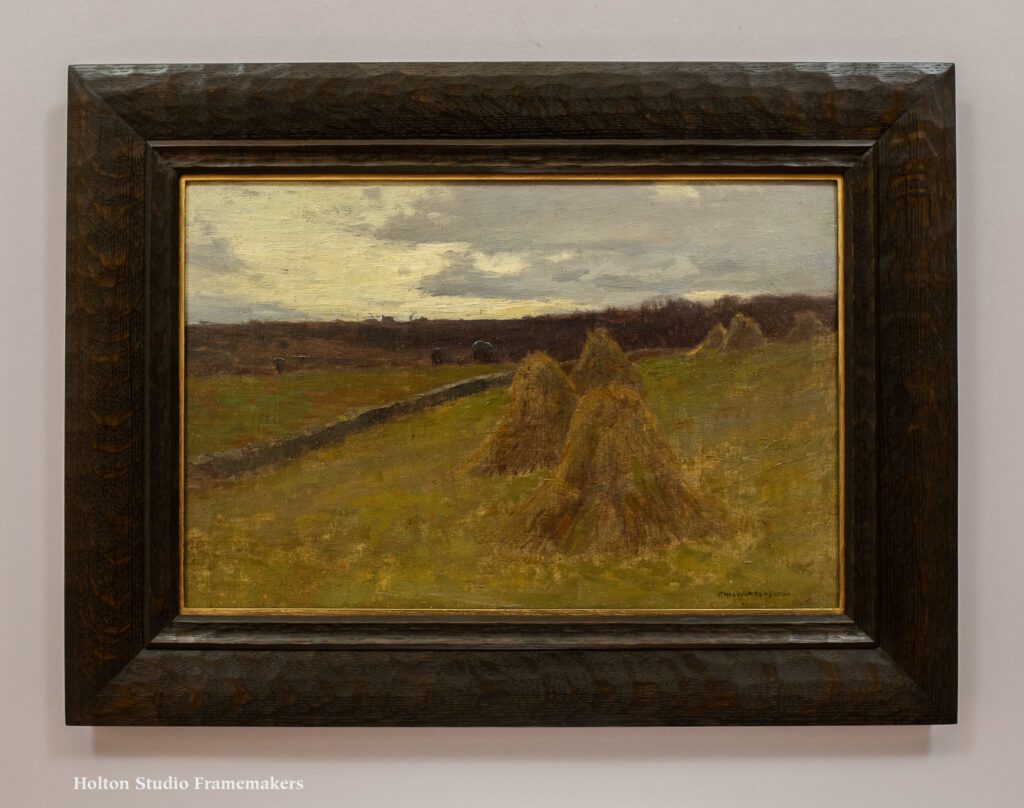
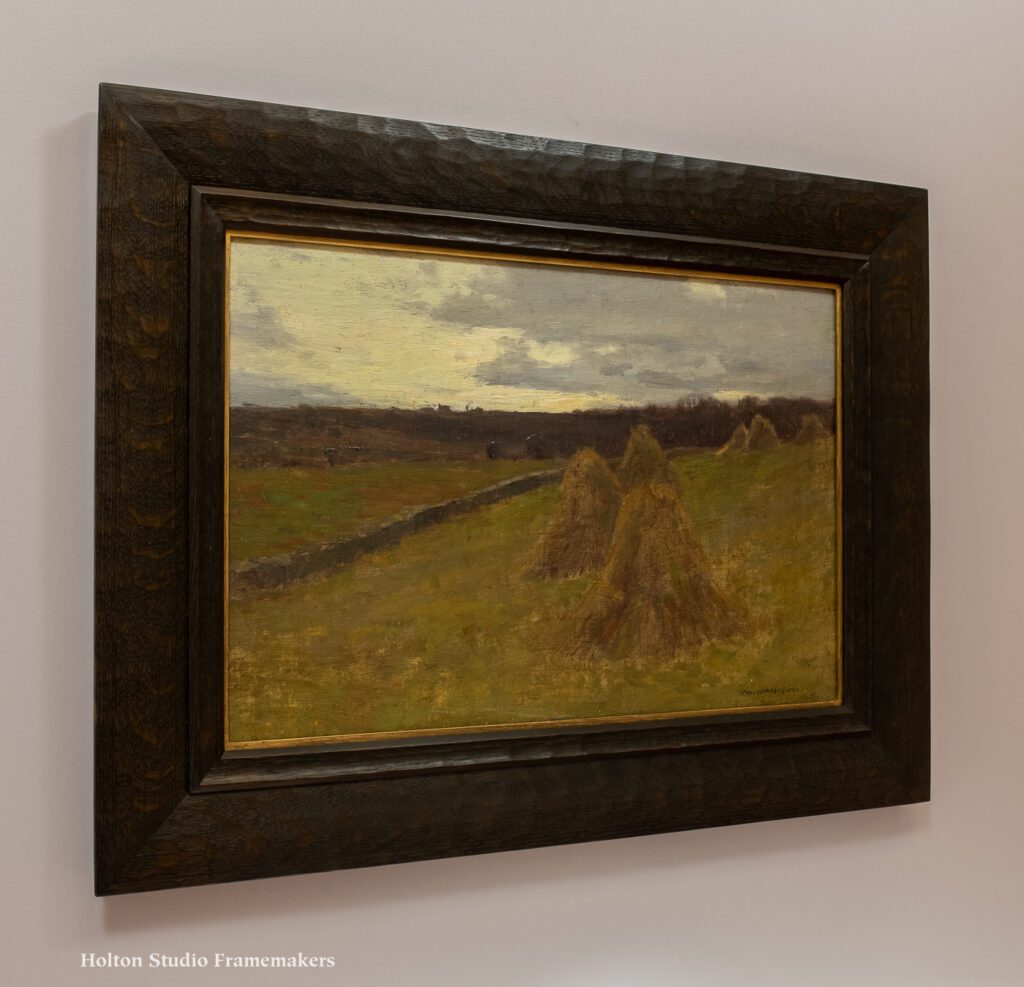 The 12″ x 15″ “Rolling Hills” seemed to ask for a frame to simply sustain the grassy bowl—a slope that coves up to a carved cushion. The stained walnut frame has a carved and bronzed liner and a coved back (see second photo). Available here.
The 12″ x 15″ “Rolling Hills” seemed to ask for a frame to simply sustain the grassy bowl—a slope that coves up to a carved cushion. The stained walnut frame has a carved and bronzed liner and a coved back (see second photo). Available here.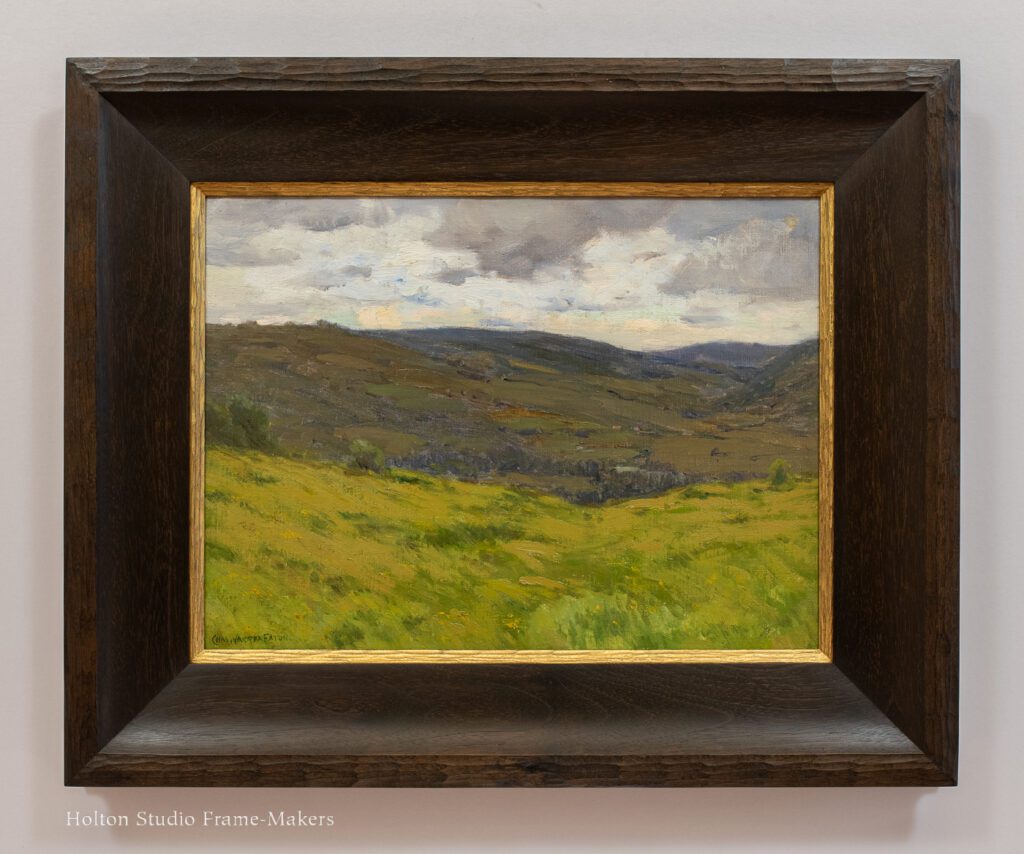
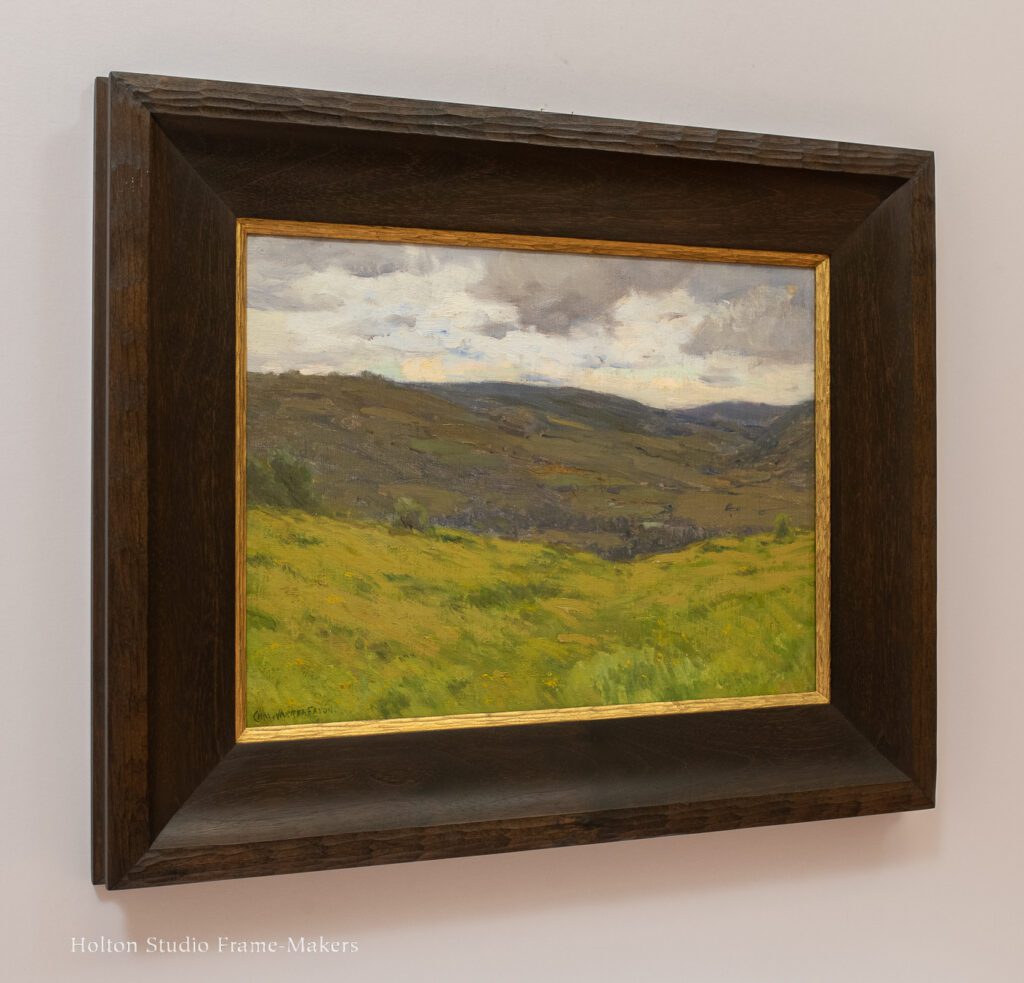 The small, 10″ x 8″ “Winter Woods” is in our No. 1.4 CV at 2-1/2″ wide in quartersawn white oak with Saturated Medieval Oak stain and a bronze wax slip. The carved cushion at the sight edge echoes the tree trunks. This painting is available here.
The small, 10″ x 8″ “Winter Woods” is in our No. 1.4 CV at 2-1/2″ wide in quartersawn white oak with Saturated Medieval Oak stain and a bronze wax slip. The carved cushion at the sight edge echoes the tree trunks. This painting is available here.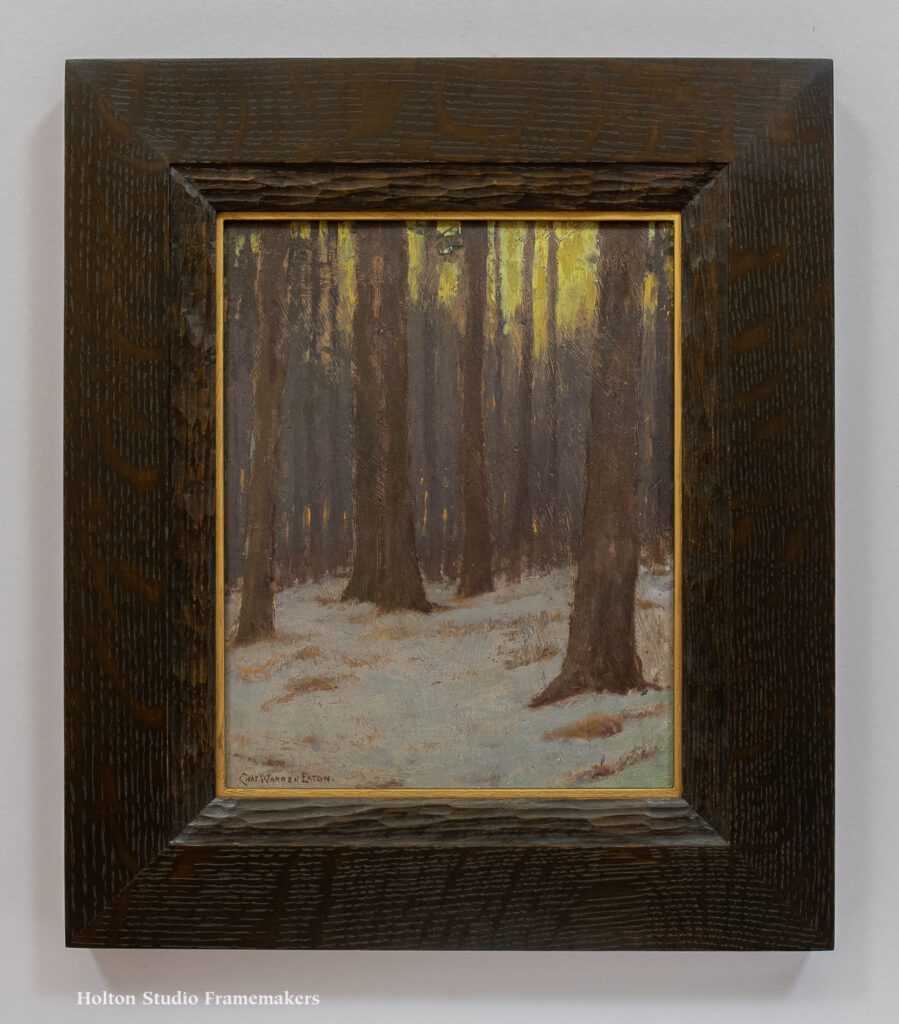
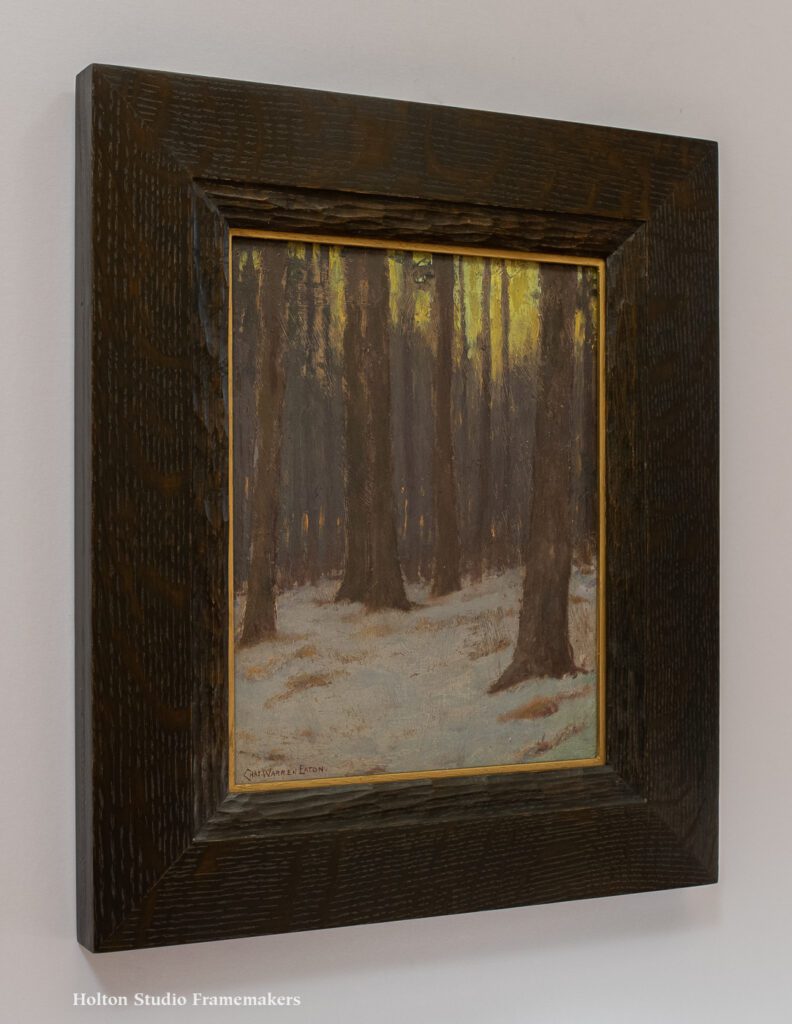 “Tall Pines,” below, captures the subject matter Charles Warren Eaton was best known for. We set the 16″ x 12″ painting in a 3″ wide No. 410 CV in fumed quartersawn white oak with a bronze wax slip. The design is all about harmony of shape and texture. The strong perspective of the painting is enhanced not only by the frame canting inward, but by the graded widths of the three elements. (This one has sold.)
“Tall Pines,” below, captures the subject matter Charles Warren Eaton was best known for. We set the 16″ x 12″ painting in a 3″ wide No. 410 CV in fumed quartersawn white oak with a bronze wax slip. The design is all about harmony of shape and texture. The strong perspective of the painting is enhanced not only by the frame canting inward, but by the graded widths of the three elements. (This one has sold.)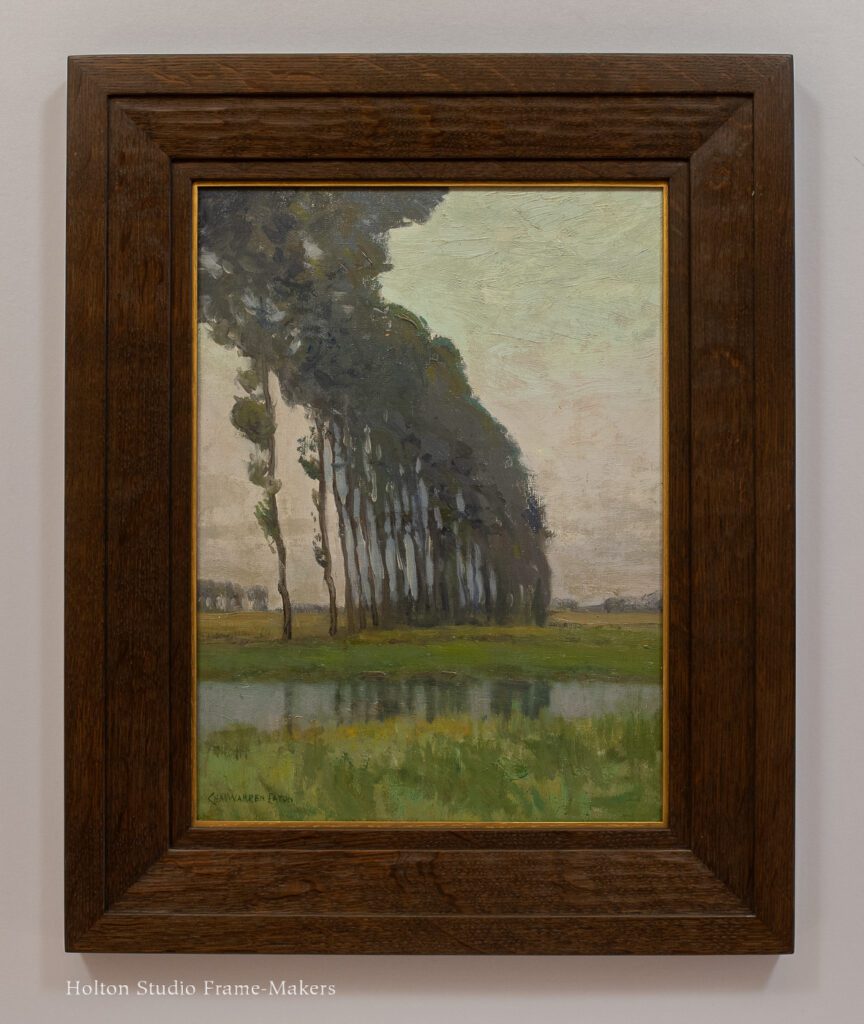
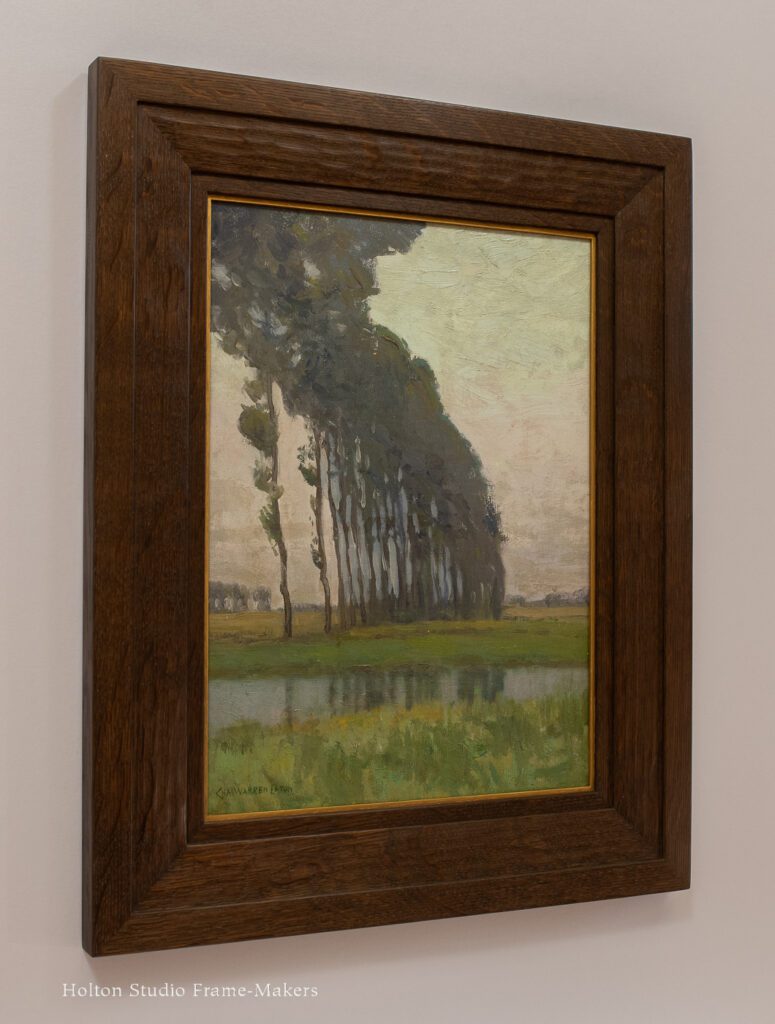 Above all, tonalism’s reverence for nature is powerfully underscored by the beauty of a hardwood frame, one well-crafted—imbued, that is, with that reverence for life, that ethos of care for nature and the world we inhabit; an ethos we share with tonalist painters like George Inness and Charles Eaton.
Above all, tonalism’s reverence for nature is powerfully underscored by the beauty of a hardwood frame, one well-crafted—imbued, that is, with that reverence for life, that ethos of care for nature and the world we inhabit; an ethos we share with tonalist painters like George Inness and Charles Eaton.